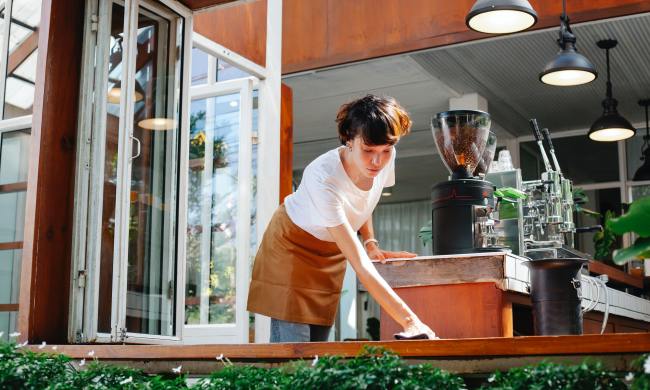Overnight parking and cleaning are often overlooked, but they’re very important aspects of operating a food truck business. Without an area to store your food truck, you’re looking at expensive insurance and lots of inconveniences. Most cities have commissaries with secure parking specific to this need.
You can deep clean, sanitize, and refuel at commissaries, too. If you’re not worried about having enough space for upkeep to follow the health codes for your food truck, you also risk the future of your business. Not complying with regulations and ordinances is usually expensive with fees and fines and can result in license and permitting revocation.
Read on to learn all you need to know about these critical operational aspects of owning a food truck. Next time, you’ll be prepared when it comes to parking and cleaning your food cart.
Where business owners put their food carts at night
Food trucks don’t operate 24/7. That means they need a place to sit overnight. Experienced food truck owners know the best place to park is a commissary, which is somewhere you can fuel up and sanitize your truck. Here’s a breakdown of the best places to park overnight.
Indoor parking
Your best parking area is space dedicated to larger vehicle indoor storage. This likely comes with a rental fee, but you’re paying for more than parking. You’re likely investing in decent security and protection from weather incidents.
Although this is the most expensive type of overnight parking, if your food truck is your full-time business, it’s worth the investment. You can usually park at local storage facilities and other large warehouse structures.
Outdoor parking
You may find free or much more affordable outdoor parking. Some of these areas come with carport coverings and some do not. You may even have outdoor parking with a security gate. Although you’re saving on parking costs, you lose out on security and have more exposure to the elements.
Private or restricted parking
If you operate your food truck in a smaller area, your best bet may be private parking. These prices are often negotiable and in unusual areas. You may find an overnight space perfect for your route, too. If you use private parking, make sure your insurance covers any potential damage.

How business owners keep food carts clean
Cleaning a food truck involves a few methods. Some cleaning happens based on cuisines, such as fish, pork, or beef. There are standard sanitary practices whenever you cook, such as switching cutting boards, trash removal, and wiping down prep and cook areas.
Other cleaning methods you do at the close of the business day or a shift (if you have employees). Cleaning routines for end of day or shift can include:
- Cleaning fryers, microwaves, and grills
- Sanitizing all surfaces
- Securing inventory storage
- Washing floor mats
- Sweeping and mopping the truck floor
- Changing linings on the grill, range, and flat-tops
- Washing tools and hood filters
These are just daily cleaning tasks. There are also weekly and monthly cleaning routines needed. How clean are food cart interiors and exteriors without a routine schedule? A weekly cleaning schedule should include:
- Deep cleaning and sanitizing coolers and refrigerators
- Removing lime buildup from sinks and faucets
- Cleaning the coffee and drink machines
- Cleaning ovens
- Oiling down cast-iron cookware
- Draining and rinsing water systems
Monthly cleans should be even more detailed. It’s important your food truck equipment gets a deep cleaning, especially in hard-to-reach areas.
- Remove grease buildup on hotlines
- Clean freezers
- Sanitize ice machine
- Calibrate ovens and thermometers
- Wash walls and ceilings
- Wipe down dry storage
- Restock first-aid kits
- Update material safety data sheets (as needed)
Is it safe to eat from food carts?
Gone are the days where food carts go unlicensed and are in violation of health codes. Sure, some food trucks offer a greasy spoon aesthetic, but that’s all it is. If you’re worried about a food truck or cart’s cleanliness, then simply don’t eat there.
If a food truck owner is up to code, they’re likely serving from a clean truck. Since most food truck cuisine comes on disposable dishes and with disposable flatware, you don’t have to worry about clean dishes. Your biggest concerns may be clean prep and cooking surfaces.
You can likely see inside the food truck. If you’re not seeing the sort of sparkle and shine that makes you comfortable, order from a different food truck. Otherwise, except that even the cleanest kitchens, mobile or otherwise, appear dirty with use. Even with daily wipedowns of grease and smoke, there’s still may be some residue.
How do food carts employees wash dishes?
Dishwashing for food trucks isn’t the same as for restaurants. Most dishes are disposable, at least for what customers receive. Utensils and food trays are often plastic or paper consumables.
It’s the actual dishes, pans, pots, and fry baskets that employees wash in a food truck. Cleaning these dishes is simple enough if the truck owner cleans out their food truck water system on a regular basis. The easiest way to ensure clean dishes is with clean water.


